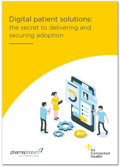Adoption is crucial to the success of any digital health solution. Despite acceptance in the medical industry that digital health solutions have evolved from a ‘nice-to-have’ to a vital component of healthcare, adoption rates remain stubbornly low. Securing adoption might sound simple but it isn’t easy. Planning for successful adoption must begin even before development and be an intrinsic part of the design and development process throughout.
Understanding both the HCP and the patient experience is key
Digital health solutions have the potential to improve healthcare and patient outcomes, but only if they can fit into care pathways without demanding extra work from HCPs. We need to expand our understanding of doctors to encourage adoption. This means examining their daily realities and going beyond acknowledging that they are ‘time poor’ and ‘change averse’. This will lead to the creation of solutions that are meaningful and seamless to use, requiring no additional time commitments from a HCP. Ensuring the solution is well integrated with the existing healthcare system will improve adoption into everyday practice.
For patients and carers, a solution that meets their clinical and emotional needs, that fits easily into their day to day lives, and helps establish patterns of behavior, will deliver immediate value and sustain their adoption and long-term interest. This means identifying a service that goes beyond clinical requirements and addressing a wider range of issues, for example the initial distress after diagnosis or medication adherence.
Plan for adoption from the first stage of development
A common mistake is assuming that the process of securing adoption for a digital solution begins at its launch; adoption must be planned for throughout the design and development process.
We see over-focus from many developers on user experience (UX) and user interface (UI) during the development stage. While necessary, it often comes at the expense of research into what drives acceptance by the key stakeholders and what motivates them to adopt the solution.
Approaches like experience mapping can ensure your digital solution helps solve real unmet needs of stakeholders by identifying all the challenges end users are facing. The insight gained allows the development of a solution that provides the greatest value across your entire stakeholder map, ultimately motivating usage and driving adoption.
Use behavioral science approaches to increase adoption
Gaining adoption requires understanding all users and stakeholders of your solution – including HCPs, patients, payors, and providers – and analyzing the behaviors, motivators, and barriers that will influence adoption
Begin by defining the health behavior challenge and then identify a solution that could address it. From there, it is essential to analyse the factors that could affect a solution’s adoption, an understanding of which requires the application of behavioral science principles.
Leveraging behavioral science and analyzing a user’s capability to use a digital solution, the motivations they may have to use it, and the external opportunities that can influence whether it is available to them, can lead to solutions that drive adoption.
Create a minimum viable product (MVP) as your starting point
The first version of your digital health solution should be viewed as a ‘minimum viable product’ (MVP). The real-word data the MVP generates regarding regional market requirements and the individual needs of stakeholders, helps shape your digital health solution into one that addresses un-met needs and nuanced differences on an individual, local, and national basis, resulting in a greater chance of adoption.
Adoption shouldn’t be overlooked or assumed as a given. But planning from the start, launching and MVP, and planning to grow and scale a product on a solid foundation of real-user feedback will lead to a successful product.
Next week in our Digital Health 101 series we will look at digital health regulation.
For more information on adoption in digital health, download our whitepaper Digital patient solutions: the secret to delivering and securing adoption:



